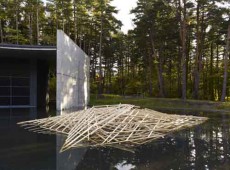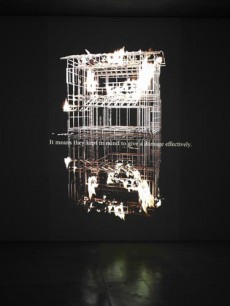
kaetemiru–Time For A Change
10:00am-6:00pm, October 22 — December 11, 2016/ admission free
KAMATA Yusuke
鎌田 友介

"The House"
wood,video projection
(approx.15minutes),2016
photo: YAMAMOTO Tadasu
Destruction and Construction Diagram
KONDO Yuki
Carrying out research through architecture, KAMATA Yusuke has attempted to present again, in his work, the construction of a manmade context in history and modernization that his research involves. In this residency production, he developed his work from his research on Japanese houses which he has been thinking over in his mind for several years.
For the work The House, he researched into Japanese houses constructed for different reasons and purposes at different places in different periods, and by reorganizing the fragmented information that he acquired, he shows another appearance of the same building. In this work, the following Japanese houses are the subjects: a house existing in Japan and still in use, a Japanese house the United States military built in the Utah desert in the incendiary bomb experiment for attacks on Japanese mainland during the World War II, and a Japanese house built in Korea under Japanese rule between the 1910s and the 1930s which still remains there with some exterior renovations.
Thorough research and local data collection were conducted, but details of the materials are not presented in the work. The work consists of combined images and superimposed interviews of people who are involved (a woman living in the Japanese house in Tokyo, an old woman who lived in Busan until she was ten, a Korean woman whose relative used to live in the Japanese house in Busan, and an Aomori-based architect). They talk about personal experiences about the Japanese houses and their impressions. The historical facts as a result of the research are left implicit through fragmented images and words.
Before the production of the video, a structure of the same size as the Japanese two-story house was built using scantling in the middle of the Water Terrace outside the ACAC building. (fig. 1) The structure of the height of 7 meters is reflected on the water surface of the shallow pond, and presents itself on the water surface as a quasi-image of the Japanese house extending deep in the water. The relationship between the real and virtual image was reflected on the structure on the video shown in the gallery. A six-meter high image is divided into two, and the house is turned upside down by the horizontal line in the center. It corresponds to the real image on the water and the reflected image on the water surface, which are suggestive of the real and virtual images of the existence of the ‘Japanese House.’ The drawing depicted in the space, or this structure like an engineering drawing, was burnt, destroyed and captured symbolically into the work.
To begin with, this very structure installed on the water is likely to be positioned as a virtual image of the Japanese house constructed in real space. The structure was built in the center of the pond, located between the high-rising northern woods and the gallery designed by ANDO Tadao with features of modernist architecture that effectively incorporates vertical and parallel. As it was placed on the water between nature and modernist architecture, the structure looks like a frame-like form lacking reality in the course of history when the style of wooden architecture established on the basis of the natural features of Japan is revalued because it is incorporated into the context of modernism.
From another point of view, a Japanese house as a symbol of the good old days that constitutes an archetypal image of Japan boasts being a symbol of Japanese identity. However, it was not evaluated for its indigenousness from a vernacular perspective (while it requires an outsider’s view). Here, Kamata points out a man-made movement during the war, in which Japanese wooden architecture was connected to the context of European and American modernist architecture, which began with Bruno TAUT’s evaluation of Katsura Imperial Villa, in order to establish cultural justification and ethnic identity through that evaluation. [1]
In his past works, Kamata explored the history of war and energy industry through architecture and attempted to present some kind of distortion in modernization. (fig.2) What he is trying to show in his work is not simply the other side of modern history or buried history during wartime, but it is probably a structure of power and force generated when local and global come in contact, which is revealed through such history. His interest can be also found in his earlier works, for example, in his A hundred definitions (fig. 3; 2009, reproduction in 2010). In this work are 100 cubes, each of which looks plane, connected to make one big cube. In this installation made as if they were drawn in space, multifaceted viewpoints are introduced. The work looks different from different angles. Behind it, there is ‘a forced viewpoint’ in the relationship between the work and the viewer when seeing the work, and so, different perspectives are presented in order to reveal such compelling power. It is an attitude that applies to his work in this exhibition as well, and his research repeated from different viewpoints is a means to counter such power, and the presentation of the parallel state is used as effective measures to bring the existence of such power to light. Various forms of Japanese houses built for different purposes at different times and places symbolize history and a context manipulated by using the similarity of form. And his work comes to show doubt about the way in emphasizing its legitimacy. The core of Kamata’s work is his interest in the close relationship between arbitrary globalization of domestic aesthetic sense caused by modernization and the establishment of national identity.
Going out of the gallery after viewing the video, the viewer finds the structure of the Japanese house no longer keeping its original shape and lying in the pond. If informed that these pieces of wood are the materials that formed the structure of the Japanese house, they will be able to regain the original form in both their imagination and real space. The Japanese house, however, constructed after multiple viewpoints are incorporated, will rise again with a different meaning.
[1] According to Kamata’s lecture ‘Another History of Architecture’ given on October 30, 2016.
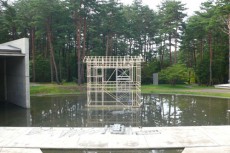
fig.1
"The House"
(the work in progress)
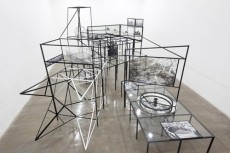
fig.2
"D Construction Atlas"
Exhibition at the Kyoto Art Center,
2014.
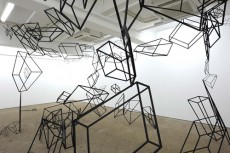
fig.3
"A hundred definitions"2009,
reproduction 2010,
Exhibition at Tokyo Wonder Site.
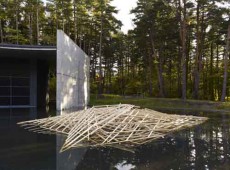
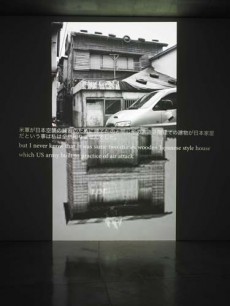
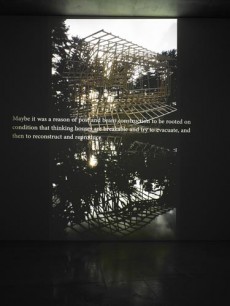
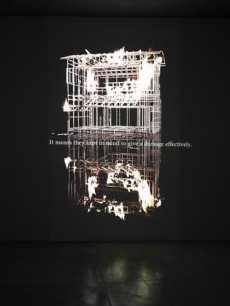
カエテミル
2016年10月22日(土)~12月11日(日)10:00~18:00 会期中無休・入場無料
鎌田友介
KAMATA Yusuke
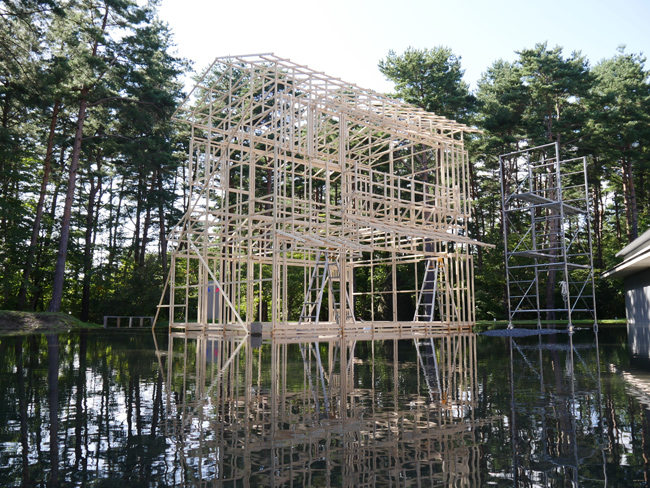
《The House》
木材、ビデオプロジェクション(約15分)、2016年
撮影:山本糾
破壊と構築のダイヤグラム
近藤由紀
建築を通じたリサーチを行い、それらが内包する歴史や近代化における人為的な文脈の構築を作品によって再提示することを試みてきた鎌田友介は、今回の滞在制作において、数年前から温めていた日本家屋についてのリサーチから作品を展開した。
作品《The House》では異なる場所、異なる時代に、異なる意味と目的のために建造された日本家屋を調査し、そこから得た情報を断片化し、再構成することで、同じ形の建造物の別の姿を表している。今回の作品では、現存し現在も使われている日本にある家屋と、第二次世界大戦中にアメリカ軍が日本本土攻撃のための焼夷弾実験の際にユタ州の砂漠に建てた日本家屋、そして1910年代から30年代に日本が韓国を統治した際に建設され、外面に変更を加えながらもいまだ現地に残っている日本家屋が対象となっている。
綿密な調査や現地への取材が行われているが、作品ではそれらの資料が詳細に提示されているわけではない。作品は、組み合わせられた映像と、その映像に重ねられているそれぞれの関係者(東京の日本家屋に住む女性、10歳まで釜山に住んでいた老女、釜山に住む親せきが日本家屋に住んでいたという韓国人女性、そして青森市在住の建築家)による日本家屋についてのごく個人的な体験や感想としての語りによって構成されており、調査結果としての歴史の事実は、その断片的なイメージと言葉の中からそれとなく窺い知ることができる程度にとどめられている。
映像作品の制作以前に、小割で組まれた二階建て家屋と同じ大きさの構造体がACACの野外、水のテラス中央に建てられた(fig.1)。約7m高の構造体は、浅い池の水にその姿を反映させ、深く水底に延びるようにみえる仮象像としての日本家屋の姿を水面に現前させる。この実像と虚像の関係は、ギャラリーで展示された映像作品の構造に反映された。6m高の縦長の映像は上下に分割されており、中央の水平線を軸に上下が反転された家屋が映され、丁度水面の上にある実像と水面に写る反射像と重なり、「日本家屋」という存在の実像と虚像を暗示する。空間に描かれたドローイング、あるいは設計図のように建造されたこの構造体は、焼かれ、崩され、その姿が映像作品の内に象徴的に取り込まれた。
ところでそもそも水面に設置されたこの構造体自体が、現実空間に建造された虚像としての日本家屋として位置づけられているといえるだろう。垂直と平行を効果的に取り入れたモダニズム建築の特徴を備えた安藤忠雄設計のギャラリーと、高くそびえる北国の森に挟まれた池の中央に建てられた構造体は、自然とモダニズム建築の間の水の上に置かれることで、日本の風土を背景に確立されてきた木造建築の様式が、モダニズムの文脈に取り入れられることで再評価されていくその歴史の推移の途中に実在感を欠いた骨組みのような姿で置かれているようにみえる。
日本の原風景を構成する古き良き時代の象徴としての日本家屋は、一方で日本人のアイデンティティを象徴する存在として誇られている。しかしそれはヴァナキュラー的な観点(それも外の眼を必要とするのだが)からその土着性が評価されたのではない。鎌田はここにタウトの桂離宮に対する評価から始まる日本の木造建築を欧米のモダニズム建築の文脈に接続させ、その評価をもって文化的な正当性と民族的なアイデンティティの確立しようとした戦時中の人為的な動きを指摘する[1]。
これまでの作品でも鎌田は建築を通じて戦争やエネルギー産業の歴史を掘り下げ、近代化におけるある種の歪みを提示しようとしてきたが(fig.2)、鎌田が作品において示そうとしているのは、単に近代史の裏側や戦時の埋もれた歴史ではなく、それらを通じて顕在化するローカルとグローバルが接触する際に起こる権力や力の構造といえるだろう。その関心は初期の作品においても見出すことができる。例えば2009年に制作された《100の定義》(fig.3.)は、平面的に見える立方体が100連なって一つの立方体を作るという作品である。空間にドローイングするように作られたこのインスタレーションでは、作品における多視点の導入が試みられている。様々な位置からみることで、作品の見え方が変わるという作品であるが、その背後には作品を見る際の作品と鑑賞者の関係に、「視点の強要」を読み取り、その強制力を顕在化させるために異なる視点を提示している。それは今回の作品にも通ずる態度であり、視点を変えて繰り返し行われる調査は、こうした大きな力に対抗するための手段であり、パラレルな在り様の提示は、その力の存在を暴くために有効な手段として用いられている。こうして異なる時間、異なる場所に異なる目的で建造された日本家屋の様々な在り様は、形の類似性を利用して操作された文脈や歴史の象徴であり、作品はその正当性を強調するやり方に対する疑念を示すこととなる。鎌田の作品においてこの近代化の折りに引き起こされたドメスティックな美意識の恣意的なグローバル化と、国家的なアイデンティティの確立の密接な関係に対する関心をその中心にみることができる。
ギャラリーの映像作品を見た後、外に出ると、野外の池では崩れてもはや元の姿をとどめていない日本家屋の構造体が池の中に横たわっている。その木片はかつて日本家屋の構造体を形作っていた素材だと知れば、それらは想像上においても、現実空間においても再び元の形を取り戻すこともできる。しかし複数の視点を取り入れた先に立ち上げられた日本家屋は、異なる意味をもって再び立ち上がるのだろう。
[1] 鎌田友介レクチャー「別の建築史」での発言より(2016年10月30日)。

fig.1
制作中の《The House》
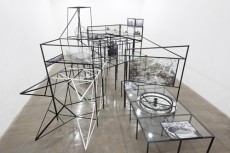
fig.2
《D Structure Atlas》
水戸芸術館での展示、2013年
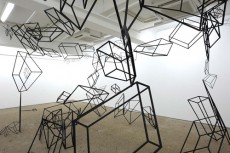
fig.3
《100の定義》2009年
2010年再制作、
トーキョーワンダーサイトでの展示
